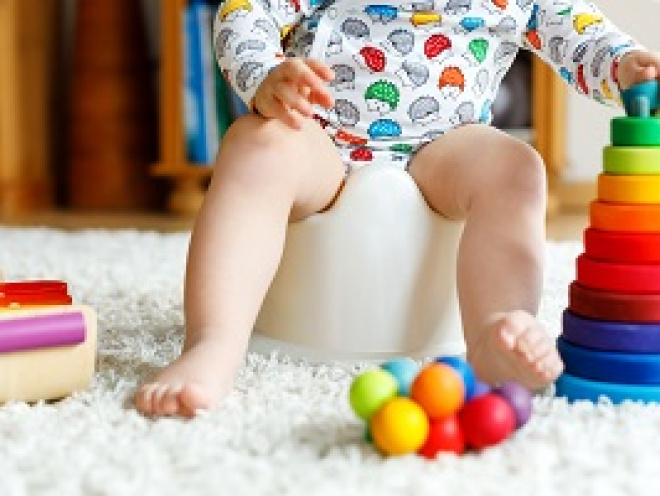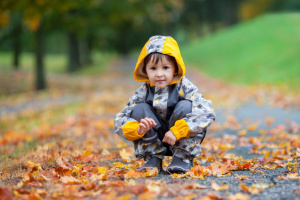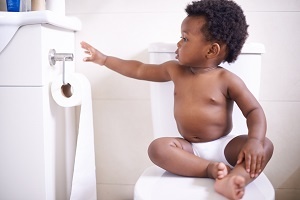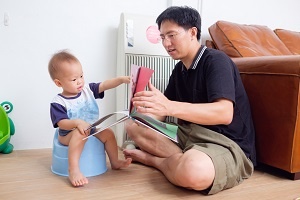Potty training helps your child use the potty, which is a step towards using the toilet independently. Read on for our top tips for potty training success.
Learning how to use the potty and toilet are major milestones for your child.
Potty training can take patience and it can be hard to know how to get started. Read on for our handy tips to successful potty training. With these tips and your patience, your little one will soon be impressing you with their new prowess on the potty.
Here are ten top tips for potty training:
1. Be prepared
Your toddler might enjoy a special shopping trip to choose a potty or toilet training seat. You can also encourage them and get them excited about potting training by letting them choose their own pants, knickers or pull-ups.
Some parents like to buy a potette or travel potty designed for taking out and about. While others simply use toilet facilities while on the go.
2. Put the potty out
It’s a good idea to put the potty out at home where your toddler can see it and get used to it before you start potting training in earnest (NHS Choices, 2015). Let your little one see and explore it and talk to them about how they can use it. They may like to sit on it fully clothed first.
Some parents will put a couple of potties out around the home, to avoid a quick dash up or down stairs.
3. Talk about the toilet
Now is the time to get chatty about the potty and toilet. Explaining all about wees, poos, the potty and toilet to your toddler can help them understand more about the process.
They might already be showing an interest in finding out more by following you to the toilet and watching what you do. Talk to them about the toilet, show them how the flush works and explain how important washing hands is.
4. Are they ready?
It’s a good idea to only start potty training once your little one shows signs they are ready for it (NHS Choices, 2015). Rather than trying to get them to do something they may not be ready for.
If you do start potty training and it’s not successful, don’t worry too much. Setbacks or regressions can happen and are normal. You can keep their potty out in view, take a break from potty training and try again in a few weeks (ERIC, 2010).
5. Natural timing
If your tot tends to go to the toilet at the same time each day, for example first thing in the morning, take advantage of this daily habit. Try keeping their nappy off and suggest they try using the potty first thing, or if they tend to go after a meal try then. You might also start to recognise signs they are about to go and may be quick enough to encourage them onto the potty in time (Hatch, 2017).
6. Washing hands
Teach your toddler about washing hands and good hygiene from the start of potty training. If they don’t like washing their hands you can try to make it more fun by singing songs and letting them play with the soap. It’s good to explain to them why it’s important to wash hands after going to the toilet - to keep bugs and bacteria at bay.
7. Make it fun
Learning to use the potty and sitting on the potty doesn’t have to be a boring activity. It might help to chat to your little one about everything in the bathroom or read them stories. Praising your child for their efforts will encourage them and is usually met with enthusiasm (ERIC, 2010).
8. Be calm and patient
Using a potty is learning a completely new skill for your child. It might take time to master it and it’s best to go at your little one’s pace. Children learn to control their bladder and bowel when they are physically ready and when they want to be clean and dry. It can sometimes feel frustrating, but they will get there in their own time and you will be so proud when they do (NHS Choices, 2015).
9. Accept the inevitable
It’s inevitable that there will be little accidents and sometimes potty training setbacks or a regression (NHS Choices, 2015). The best thing to do is accept that learning a new skill like using the potty is like anything new – it takes time, and practice makes perfect. Try to pack a bag with a change of clothes, along with toilet paper or wipes, for when you go out and about, so you are prepared for any mishaps.
10. Be positive
Stay upbeat and help motivate your little one (ERIC, 2010). Praise them for trying or doing well on the potty. Most toddlers react well to lots of praise and encouragement and will be more likely to ask to use the potty or toilet themselves. You might also find your child responds enthusiastically to a sticker chart or reward chart.
Potty training requires your patience and your little one’s concentration. Like many other child development stages, your toddler will learn to use the potty when they are ready.
This page was last reviewed in June 2018
Further information
Our support line offers practical and emotional support with feeding your baby and general enquiries for parents, members and volunteers: 0300 330 0700.
You might find attending one of our NCT New Baby courses helpful as they give you the opportunity to explore different approaches to important parenting issues with a qualified group leader and other new parents in your area.
Make friends with other parents-to-be and new parents in your local area for support and friendship by seeing what NCT activities are happening nearby.
NHS Choices has more information on potty training.








